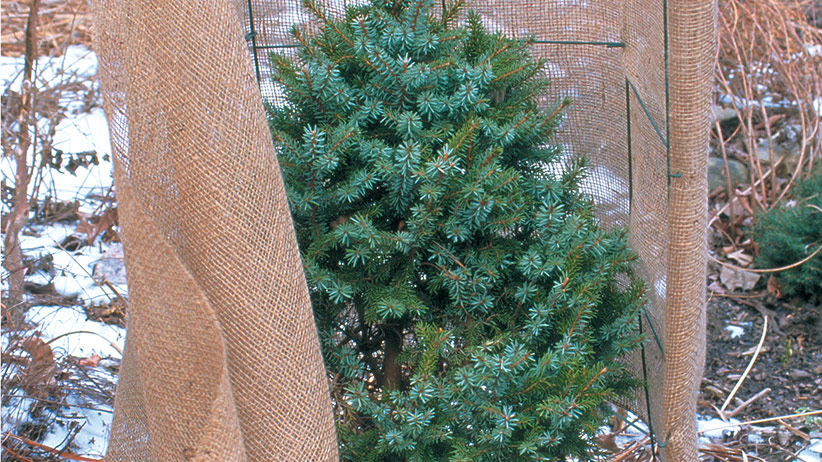Fall tree & shrub care
Autumn is when many trees and shrubs really shine. You may be raking this fall, but it’s also a good time to take care of these plants in other ways. Here are three must-know pieces of advice to help your garden have spectacular trees and shrubs in every season and every year.
3 Ways to protect trees & shrubs through winter

1. Protect trees & shrubs against winter damage
Between munching critters, temperature changes and harsh winds, it’s a wonder any plants survive winter. Here are three problems your trees and shrubs might have and how to help.
Add fencing to defend against nibbling critters
During winter, plants start to look appetizing to hungry critters. Rabbits and other animals damage shrubs by gnawing the branches. Bind the branches together so they don’t poke through the wire, and place a cage of chicken wire, like the one above, around the plant. Use stakes to keep the fencing in place so animals can’t dig under the edge. And make sure the fence is high enough to protect your shrubs even if there’s a snowdrift for the rabbits to stand on.
You Might Also Like:
6 Ways Winter Can Damage Plants
Are You Using the Right Type of Mulch?
Deer-Resistant Shrubs

Wrap trees to protect from frost cracks
Winter temperatures can change dramatically from a warm, sunny afternoon to a subzero nighttime. That causes the layers of thin, young tree bark to expand and contract at different rates, eventually causing it to split. Protect thin-barked trees for five years or so by wrapping the trunk with tree wrap. The white wrap above is best at reflecting the sun, but any wrap is better than none. Start at the bottom and work up to the first set of branches, then secure the wrap with tape at both the top and bottom. Remember to remove the wrap in spring so insects won’t move in for the summer.

Protect trees & shrubs from wind and sun damage
Dry wind and bright sun can cause serious problems for both broadleaf and needled evergreens. Plants like junipers (Juniperus spp. and hybrids), arborvitae (Thuja spp. and hybrids) and boxwood (Buxus spp. and hybrids) often turn brown on the exposed, sunny or windy side, while the protected side stays green. Damaged foliage usually won’t come back. Drape burlap over a tomato cage or wrap the fabric around the plant and tie it in place. The burlap will protect the foliage from drying winds, scorching sun and extreme temperature changes.
You Might Also Like:
How to Deal with Boxwood Blight
Designing With Conifers in the Garden
Get to Know Different Types of Conifers

2. Plant trees & shrubs in fall
Fall is a great time to plant container-grown and balled-and-burlapped trees and shrubs. Early in the season, soil temperatures are perfect for establishing new root systems. Plant deciduous trees and shrubs from late summer to midfall. Evergreens do better with slightly warmer soil temperatures, so don’t plant them after early fall. Not only is fall a good time to plant, it’s also a good time to pick up great buys on closeout sales.
Five trees you should NOT plant in fall
However, there are a few cases where it’s best to wait until spring. Trees and shrubs that are slow to establish new root systems or have fleshy roots that dry out easily don’t transplant well in fall. Here are five trees best planted only in spring:
- Magnolia (Magnolia spp.)
- Oak (Quercus spp.)
- Birch (Betulus spp.)
- Red maple (Acer rubrum)
- Dogwood (Cornus spp.)
3. Water newly planted trees and shrubs
Plants need water, even when the ground’s frozen. Whether you’ve planted new trees and shrubs or have established specimens, give them all a good drink before the ground freezes, so the water can soak in. Since evergreens support foliage all year, it’s especially important that they have enough moisture. During a mild winter, or if you live where the ground thaws periodically, give them a little extra water to keep them going.
You Might Also Like:
When Should I Stop Watering My Garden in Fall?
Pros & Cons of Different Types of Garden Hoses
Gardener's Problem Solver Collection
















